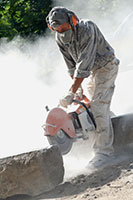It’s no secret that safety is top priority at Desert Diamond Industries. We are the home of The Safety Blade™ as well as the Lifetime Operator Error Warranty.
Desert Diamond Industries believes that there is absolutely no excuse for selling unsafe products. You have the right to the safest and most effective tools that you can get.
We have been distributing safe products to the cutting and grinding industry since 2008, and our desire to increase safety in the industry has only grown over time. In recent years, Desert Diamond Industries began creating and distributing safety training courses, as well as hosting safety demonstrations for companies and schools. It is immensely gratifying to provide students and employees with knowledge that will keep them safe in their field.
We have created the Desert Diamond Industries Give Back to take our safety mission one step further.
The Give Back is designed to help underfunded welding programs across America. The Give Back is tailored to the specific needs of the chosen school of the month. We provide these programs with donations of our signature Safety Blade™, along with monetary donations to help the program provide their students with the best equipment available.
Each month we pick a school to sponsor, and Desert Diamond Industries’ sales determine the donation awarded. For every 15 safety blades Desert Diamond Industries sells, we give one to a program in need. We also accept and encourage donations for the Desert Diamond Industries Give Back; all proceeds go to the sponsored school of the month.
In November we chose our first school to sponsor: The East Tech Titans! Thanks to our loyal customers, and the support we received at the Fabtech Trade Show, we presented the students at East Career & Technical Academy with a check for $1,500 as well as $2,500 worth of Safety Blades! Alongside our CEO, Nicholas Mione, we spent a day at East Tech working with the students. Nicholas led a hands on demonstration using Desert Diamond Industries equipment, and administered our safety training course. It was an exciting day with the Titans!
Watch East Tech’s Thank You Video Here!
We are looking for the next school to sponsor! If you know of a program in need, please contact us for consideration.
Please email a submission video to christinac@thesafetyblade.com
Submission Requirements:
A short video describing the scope of the program, number of students in the program, and why we should pick you to be the next Desert Diamond Industries Give Back school.



 “I believe in a world without conventional abrasive blades! I believe that every worker has a right to use the safest, most effective tools to perform their craft and to contribute to society as a whole.”
“I believe in a world without conventional abrasive blades! I believe that every worker has a right to use the safest, most effective tools to perform their craft and to contribute to society as a whole.”


